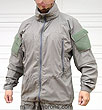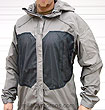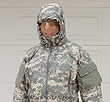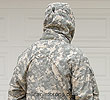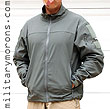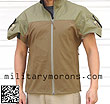Non-Insulated Soft Shells Page 1 Page
2 Page 3 Page
4
As a sizing reference: I'm 5'7", 155 lbs (yeah, I'm a little guy), medium build (BDU top medium/regular, BDU pant medium/short), waist 32", chest 43". Keep this in mind when you read my comments with respect to sizing, so you have an idea of how the garments featured below will fit on you. ALL garments in these pages are size Medium, unless stated otherwise.
TO VIEW FULL SIZE IMAGES: USERNAME and PASSWORD are both "mm"
| Military Clothing Systems Over the past decade, we've finally been seeing the
military take notice and adopt some of the advanced technology/high
performance fabrics and clothing that civilian mountaineers and backpackers
have been using for quite a while. Lighter, more compressible, breathable,
quick drying and wicking fabrics now clothe the soldier, doing their
part to make a tough job a bit more efficient and a bit less uncomfortable.
Clothing the soldier presents a unique challenge as temperatures in
certain regions may range greatly over a 24 hour period, or missions
might start off at low altitudes and end up much higher. Soldiers
most often have to be self-sufficient, carrying everything in their
rucks and on their person, so light weight and clothing versatility
rank high in importance. Unlike most sporting events, the soldier
might have to wear the same clothing for days or weeks on end, and
subject them to abuse that civilian use won't.
Typically, there can be several different manufacturers/contractors making the same garments. Sometimes different manufacturers make different levels in the same program, and I hope to feature more of them here. I'm also learning that the item of the same name might vary by manufacturer with differences in materials and features. I was surprised to find this out, and expected the garments to be more standardized. |
8/26/07 - Note that ORC Industries has ended production of the MCU items seen below and ORC has ceased to offer them. The writeup below is left as a reference.
| 4/19/06 - Orc Industries (see PCU review below for more info) will be ending their production run of the PCU L4 and L5 items (another company is continuing the contract), and are introducing their alternative, dubbed the Modified Combat Uniform (MCU). Orc's MCU L4 and L5 evolved from their PCU line, with a few minor changes, and will be offered to both Military personnel and civilians. PCU was not available in ACU (Universal Pattern), but MCU will be available in both Alpha Green and Universal Pattern (as an alternative to the equivalent ECWCS Gen III items). Since the MCU items are very similar in design to the previous PCU articles, I'll focus on the differences, rather than the similarities. Please refer to the ORC PCU review section following this one for more info. MCU Level 4 Windshirt
- The Windshirt is designed to be worn in combination
with base layer garments when wind resistance is needed to limit further
heat loss. The main change for the MCU L4 Windshirt is that it is
now has a full zip instead of half-zip, and made from different fabric.
PCU fabric was Epic Praetorian, and the new MCU is made from Ecology™
by Brookwood.
Ecology is a rip-stop nylon fabric engineered to be water resistant,
breathable, windproof and very packable. Taking a close look at the
fabric reveals the rip-stop weave. It's very light weight and more
packable than the PCU L4 Windshirt I have (compresses to the size
of a softball), and from a brief stint out in the rain, and also some
rudimentary water tests I did, has similar water-resistance characteristics.
This is NOT rain gear - water WILL eventually soak through if left
on the fabric long enough, or if pushed through with enough force
(as in a heavy rain), just like the PCU L4 windshirt. Best used in
mist or light drizzle.
4/28/06 - Shown below is the Universal
Pattern L4 Windshirt. Same features as the Alpha green one, of course.
The material is the same ripstop nylon. The ripstop L4 fabric is a
close match for the L5 fabric, as seen below. It 's also more matte
than the Alpha green. To illustrate how packable it is, I rolled it
up and stuffed it into a coffee mug.
MCU Level 5 Soft Shell
Pant and Jacket - Instead
of the Epic Nextec fabric, the MCU L5 Soft Shell Pant
and Jacket are now made of Agility™ by Brookwood. It's actually
difficult to distinguish between the two fabrics, even when looking
pretty closely. The Agility is engineered with the same properties
- breathability, water resistance and wind proof, but it is not an
encapsulated fabric process like Epic. It also includes some Spandex
to give it a bit of stretch, for greater movement and comfort. I didn't
notice any difference in water resistance during some walks in the
rain. Like the windshirt, the L5 garments are not meant as a substitute
for rain gear, but to keep the user dry from drizzle or limited exposure
to rain. When wet, they do dry more quickly than an insulated soft
shell, or BDU's, though. (A short note on 'soft shells'. The term is used very loosely and usually describes a garment that is 'water and wind resistant, breathable, but not water-proof'. They range from lightweight single-layer fabrics (like the OrdInd MCU) to thicker, stretch fabric (like Tweave used in the Arc'teryx Bravo pants) to micro-fleece insulated garments (Bravo jacket, TADgear hoodie, SORD Hardface etc). An uninsulated shell allows you to layer it over a base or mid insulative garment and remove it or the mid layer if necessary during aerobic activity. An insulated shell combines the shell and an insulated layer, so if you get too warm on the move, you've less options. But I've found insulated soft shells to be very versatile, general use garments in cool weather. Bear this in mind when shopping for a 'soft shell' - there are many variations on the theme, and base your choices on your needs - the temperature you'll be using it in, and the level of activity.) The MCU L5 pant retains the same pattern as the PCU L5 with the double-layer articulated knees. The waist tabs and cuffs tabs have been refined, and overall stitching/finishing has improved. The black cordura panels on the inside of the ankle (for protection when wearing crampons) have been eliminated, and so has the rear flap with suspender loops. I'm glad they got rid of it because I never used it and I ended up folding it out of the way. If I need crampons or suspenders, I'll switch back to the PCU pant. Just like the PCU pant, the fit is a bit long for me as I've shorter legs. My size medium has a 32" inseam. There are two side zippers - the upper ones for ventilation or pass-through to pockets underneath, and the lower ones for donning over boots. The black metal vents in the cargo pockets have been replaced by sewn holes. All other features are shared with the PCU L5 pant. Also shown on the right is the MCU L5 pant in Universal Pattern.
I don't have a Gen 2 PCU L5 jacket, only a Gen 1 shown in the PCU
review below, so the Orc MCU L5 Jacket might share some of the newer
features that the PCU in my review below doesn't. The hood rolls
up and stows in the collar neatly. The hood cinch cords are actually
routed internally - located on each side of the main zipper - with
the ends passing through a grommet into the side-access pockets.
To adjust the hood opening size, you access the cord ends through
the side pockets and pull. The elastic used is of a thinner variety
than the 1/8" shock cord used on the PCU items. The issue of
durability crossed my mind but they seem to work fine for now and
time will tell with extended use. The bottom drawstring adjustment
is also routed inside the side pockets. The shoulder/arm pockets
are a little easier to access now, with no elastic in the opening.
The pocket as well as the flap is covered in loop velcro. As in
the pant, the water-resistant zippers have been replaced by coil
zippers protected by flaps. They're easier to open and close and
reportedly less likely to jam.
Shown below is the L5 Softshell jacket in Universal Camo Pattern. The correct foliage green velcro is used on the sleeves.
I think the most common issue people had with the PCU items that Orc manufactured was that the stitching and finishing left something to be desired. Stitching wasn't the tightest, with a loose threads hanging off here and there, which could lead to seam failure. In order to be competitive and appeal to both civilian and military users, Orc has made an effort to improve workmanship quality and it shows in the MCU garments. While still not as neatly finished as some of the top commercial manufacturer's garments on the inside, I did notice better overall quality than the PCU garments. Another good point, though, is the pricing. It's actually been lowered. MCU is priced below the equivalent PCU items, which further improves the performance to price ratio. Visit my Hike Photo Essay page for more pics of the MCU Level 5 jacket and PCU pants.
|
| 6/15/09 - OTTE Gear has introduced a new softshell, called the DK Jacket. Designed for movement-intensive operations and activities, it's a hoodless softshell that includes the ability to roll up the sleeves to convert it to short-sleeved configuration. The DK is not just a hoodless version of OTTE's Alpine Jacket, but a completely different cut. Material - The DK jacket comes in two fabric weights. Both are made of Tweave Durastretch fabric, which is a technical stretch woven with 91% nylon and 9% spandex for the shell/face material. It is a durable, abrasion resistant, water and wind resistant, low-bulk, breathable fabric with excellent stretch and recovery properties. The Multi-directional (4-way) permanent-stretch spandex has 100% memory for shape retention. The standard DK Jacket (pictured here) utilizes this non-lined Tweave (same as the Alpine Trouser) and is meant for warmer weather. The DK Jacket Heavy (not pictured here) is the same material as the Alpine Jacket reviewed below. Here's a summary of the features on the DK Jacket soft shell, size medium in Foliage shown:
Convertible sleeves - Now, here's the more unusual feature that the DK Jacket has to offer - it converts to a short sleeve. Not the same way convertible pants go from long to short by removing the pant leg, but by rolling up the sleeves and securing them. Sewn inside the sleeve is an elastic strap with hook velcro on the end, that stows through a slot in the inside of the shoulder pocket when not in use. With the pit zips open, the user draws his wrists back out from the cuffs and sticks his arms out of the pit zips instead. The sleeve is now rolled up on the outside, the elastic strap brought out, and velcro'd to one of the sleeve pocket velcro patches. The height of the rolled up sleeve can be varied by where the strap end is velcro'd - on the upper or lower patch. This feature was designed into the DK at the request of end users who wanted a quick way to vent and cool off excess heat without having to remove the jacket from under all their gear. When wearing plate carriers or body armour, venting out the front zipper isn't possible, so the arms were the only other place that would work. More on this later.
Sizing, fit etc - Shown here is the Medium size.
OTTE Gear soft shells have a slightly more generous fit than similar
jackets made by TAD Gear or Arc'Teryx. The DK jacket will accommodate
a medium weight base layer under it. Like the Alpine Jacket, it's
a very comfortable fit (on my build - 155 lbs, 5' 7") that's
not too snug nor loose, and without excess material so it fits under
rigs or body armour. Notes and Observations - The DK Jacket is light weight, highly water and wind-resistant and easily packable, being an unlined shell. It's also suitable for warmer temperatures than the Alpine Jacket. The huge 20" pit zips allow for quite a bit of ventilation, but of course, I was interested in trying out the short-sleeve feature. Rolling up and securing the sleeves is very straightforward. I was able to roll up both sleeves and secure them without taking the jacket off. To make the roll neater, I made sure that the velcro cuff adjustment tab was at its maximum adjustment so it wouldn't bunch up the cuff. When the elastic strap is secured to the lower velcro patch on the outside of the sleeve, the sleeve isn't rolled up as high, and access to the sleeve pocket is possible. However, I felt that it was too floppy in that configuration and when I'd move my arm up and down it'd be moving the rolled up sleeve around. The elastic strap was too long as well, and would be better at least 2" shorter so it holds the roll tighter. I then rolled up the sleeve a bit more, and secured the strap to the top of the upper velcro patch. This ended up being my preferred configuration as it got the sleeve up higher, and out of the way more. The strap could still be shorter, even in that position. The caveat to rolling it higher is that the sleeve pockets are partially rolled up as well, and aren't very accessible. However, if the user is planning on rolling up the sleeves, I'd recommend leaving them empty, or with only very lightweight items inside just to reduce 'floppage' or and bulk. Rolling up the sleeves with the pit zips open all the way releases a lot of heat - it works as advertised. MM Mod - I started to brainstorm and think about alternatives to just shortening the elastic strap. If I was going to roll the sleeves up, they might as well be all the way for maximum ventilation and the least interference. I found that rolling the sleeves up to the inside was possible, and it was also the 'cleanest' configuration. I added a strap (all I had was webbing, no elastic), sewn to the inside seam at the shoulder, which secured the rolled up sleeve. It looks a bit funky, but no more so than the original configuration. It's almost converts the jacket into a vest. Plus, it's less prone to snagging or coming undone. I've given this feedback to OTTE gear and it's up to them to decide whether they'd like to implement this additional strap as an option and also shorten the original strap.
|
OTTE Gear DK Hybrid Jacket (2010)
| 5/21/10 - Like the DK jacket from OTTE Gear, the interesting new DK Hybrid Jacket is designed for movement-intensive operations and activities, and includes the ability to roll up the sleeves to convert it to short-sleeved configuration. While similar the DK, the Hybrid is a more streamlined jacket made of a combination of hard shell and soft shell material to provide the weather protection of a hard shell in the most exposed area and the comfort and breathability of a shoft shell when worn under armour. Material - The two-tone appearance of the DK Hybrid jacket comes from its dual fabric construction. Shown here is the Earth-Light Coyote colour scheme, where the lighter earth colour on the arms and shoulders is the hardshell fabric and the darker coyote is the soft shell fabric. The hard shell fabric is of eVent's excellent 3-layer waterproof/breathable. Every fabric manufacturer claims that their fabric is the best, so it's no surprise that the eVent family of fabrics claim to be the highest performance 3 layers on the planet. GE states that their eVent Professional fabrics are developed specifically for combat and law enforcement and that the eVent Professional Line is the longest wearing, most breathable, waterproof 3 layer fabric bar none. Using advanced ePTFE membrane laminates, eVent out breathes any other high end PTFE laminate currently available. eVent claims to be more efficient at allowing sweat to escape than other membranes by eliminating the PU layer normally laminated to the ePTFE membrane to protect it from performance degradation from comtaminants like body oils. Instead, the eVent ePTFE membrane itself is treated at the molecular level to protect it, retaining the open-pore structure, and allowing moisture a more direct path to vent to the outside. Does it work better? From previous experience with eVent, I'd say 'yes'; it's the most breathable waterproof material on the market I've tried at the time of this writing. REI has a pretty cool demonstration video of it showing how easily air passes through eVent compared to another WP/B fabric. Details on how to care for eVent garments are on their web page. The soft shell fabric is Tweave Durastretch fabric, which is a technical stretch woven with 91% nylon and 9% spandex for the shell/face material. It is a durable, abrasion resistant, water and wind resistant, low-bulk, breathable fabric with excellent stretch and recovery properties. The Multi-directional (4-way) permanent-stretch spandex has 100% memory for shape retention. The Tweave used for the DK Hybrid is unlined (same as the Alpine Trouser) and is meant for warmer weather. The Tweave has a DWR coating. Here's a summary of the features on the DK Hybrid Jacket, size medium in Earth/Coyote shown:
Convertible sleeves - The DK Hybrid share the same convertible feature as the DK - it converts to a short sleeve. Sewn inside the sleeve is a length of webbing with hook velcro on the end, that stows on a patch of loop velcro inside the sleeve. With the pit zips open, the user draws his wrists back out from the cuffs and sticks his arms out of the pit zips instead. The sleeve is now rolled up on the outside (or inside), the strap brought out, and velcro'd to the sleeve pocket velcro patches. The height of the rolled up sleeve can be varied by where the strap end is velcro'd. This feature was designed into the DK at the request of end users who wanted a quick way to vent and cool off excess heat without having to remove the jacket from under all their gear. When wearing plate carriers or body armour, venting out the front zipper isn't possible, so the arms were the only other place that would work.
Sizing, fit etc - Shown here is the Medium size. OTTE Gear soft shells usually have a slightly more generous fit than similar jackets made by TAD Gear or Arc'Teryx, but the Hybrid has a more form-fitting cut for use under armour, as mentioned above. On me, it's just about a perfect fit. Notes and Observations - The DK Hybrid Jacket is light weight, highly water and wind-resistant and easily packable, being an unlined shell. It's also suitable for warmer temperatures, as I found out. The huge 18" pit zips allow for quite a bit of ventilation. Like on the DK, rolling up and securing the sleeves is very straightforward. I am able to roll up both sleeves and secure them without taking the jacket off. To make the roll neater, I made sure that the velcro cuff adjustment tab was at its maximum adjustment so it doesn't bunch up the cuff. The web strap is shorter and more secure than the elastic strap that was on the 1st gen DK, so it holds the roll tighter. The caveat to rolling up the sleeves high enough so that they don't flop is that the sleeve pockets are partially rolled up as well, and aren't really accessible. However, if the user is planning on rolling up the sleeves, I'd recommend leaving them empty, or with only very lightweight items inside just to reduce 'floppage' or and bulk. Rolling up the sleeves with the pit zips open all the way releases a lot of heat - it works as advertised. I also prefer rolling the sleeve on the inside vs. the outside as it's a bit more secure and cleaner looking. The DK Hybrid is comfortable under gear/armour, due to its sleeker/spartan design. By now, I'm sure you've noticed that it does not have the hand warmer pockets that the DK has; nor are there any chest or inside pockets of any kind. I also noticed that the quality of stitching and construction is better than the earlier OTTE products. It's cleanly finished inside; whereas earlier OTTE jackets could have had a little tighter stitching. When we had our rainy season, I wore the Hybrid out in light-medium rain and it shed it very well. The most exposed surfaces are hard shell fabric, so it takes the brunt of the rain, which doesn't quite land as forcefully on the torso (unless you're prone). When the weather warmed up, I wanted to see how stuffy it'd get, so I wore it for the whole day on a desert shooting trip in March. I'm actually surprised that it was comfortable the entire time, even though the weather ranged from mild to warm. I didn't have to take it off, nor roll up the sleeves, and the eVent hard shell material felt just as comfortable as the soft shell. I'd estimate that because of the ventilation afforded by the pit zips, it's comparable to a NYCO BDU top. It's a very nice, sleek jacket that would do well as an inclement-weather replacement for a BDU top.
|
| 3/12/10 - OTTE Gear has introduced a new light weight windshirt, called the Super L Windshirt. Designed for blocking wind and shedding light rain, it's a breathable shell that barely takes up any space at all. The Super L (Light) Windshirt is a super-packable zip-front shell that is cut roomy enough to fit over other garments to provide an additional protection from the weather. Here's a summary of the features on the Super L Windshirt, size medium in Crye MultiCam shown (it's currently available in MultiCam only):
Sizing, fit etc - Shown here is the Medium size. As mentioned above, the Super L Windshirt has a slightly more generous fit so it can be worn over other garments. Of course, this also depends on your build. I'm a 'true' medium size, and am able to wear the Super L over a TAD Gear Ranger Hoodie which is a form-fitting yet relatively thick fleece jacket. The Super L fits over my other medium-weight fleece sweaters/jackets and the Arc'teryx Atom LT. Notes and Observations - I picked up the Super L Windshirt at the 2010 SHOT show in Vegas in January when I stopped by OTTE's booth the first day I was at the show. Turns out the timing was perfect, as when I stepped out of the expo center, it was drizzling/raining and chilly outside. I remembered the Super L in my pack, put it on, and took the walk back to my hotel in the rain. It kept me dry, and in retrospect, I'm surprised it worked as good as it did because the fabric really isn't that water resistant. It's a single layer with no membrane; treated with a DWR from the factory. It depends solely on the DWR to repel water. The factory DWR doesn't seem that effective during testing, and if I put any water on it and press/rub the water, it'll penetrate without much problem. I think it worked well in the light rain because the water drops didn't have enough pressure to penetrate the DWR, and just rolled off. I performed some quick tests at home. It won't hold water in the sink - it soaks right through. Water drops on the fabric will bead up and roll off, but not if left on for a while. Water in my hand dripped onto the fabric then rubbed in will penetrate and soak the fabric. My conclusion is that it will work pretty well for drizzle but will most likely get saturated in heavy rain. One thing I did to improve the water resistance of the Super L was to use Nikwax TX.Direct Spray-on waterproofing. I wet the Super L, sprayed on the TX.Direct, let it dry, then tossed it in the drier. The fabric is much more water-repellant now, and water takes much longer to saturate the fabric. Since it has no membrane, it's very breathable. This also means that it is wind-resistant, not wind-proof. I can feel air pass through the fabric when I blow hard through it. Where I think the Super L is useful is as a light shell over a fleece garment or base layer, to help trap warm air in the insulative layer; and also to help shed light rain or snow and keep the insulative layer dry. Or as a light windshirt over a t-shirt when the sun goes down in the evening. In my opinion, the main selling point of the Super L is that it's light and packable enough to carry along when a softshell or hardshell might not be. Just how packable is it? I decided to try and find out, and was able to roll and stuff it into an EMDOM double M4 mag pouch, as shown below. That's a pretty small package! Folded flat, it'll fit easily in pants cargo pockets, jacket pockets, emergency kit, GP pouches etc. In other words, just about anywhere.
|
ATTENTION! PLEASE DO NOT LINK DIRECTLY TO MY IMAGES
-
IT RESULTS IN MY BANDWIDTH ALLOCATIONS BEING EXCEEDED,
AND MY PAGES GO DOWN. THANKS!
/ . PLEASE
OBSERVE AND RESPECT OUR COPYRIGHT! . /
©opyright by MilitaryMorons.com. All Rights Reserved. Reproduction, Duplication,
Distribution Strictly Prohibited.
Unless mentioned otherwise, content and images are the
property of militarymorons.com and are not in the public domain.
They are not to be used without
permission. Please Contact
me for permission to use any images or content herein.

















